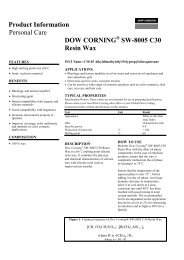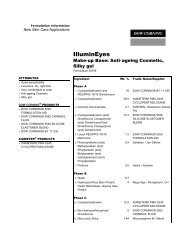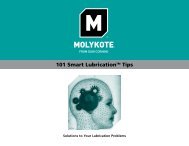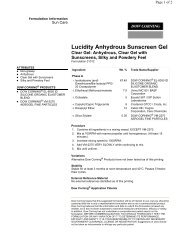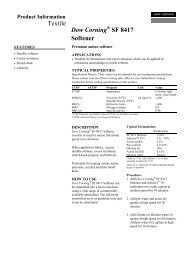Silicone rubber transfer molding
Silicone rubber transfer molding
Silicone rubber transfer molding
Create successful ePaper yourself
Turn your PDF publications into a flip-book with our unique Google optimized e-Paper software.
MOULDING OF SILASTIC SILICONE RUBBER<br />
Transfer Moulding<br />
In <strong>transfer</strong> moulding, the unvulcanized <strong>rubber</strong> is placed in a<br />
chamber (called a pot), usually at the top of the mould, and<br />
the assembly is placed in a press. The press applies pressure<br />
to a piston-Ike plug in the open end of the pot, clamping the<br />
halves of the mould together and forcing the <strong>rubber</strong> to flow<br />
through one or more sprues into the heated mould.<br />
Transfer moulding is particularly useful in producing parts<br />
whose shape is such that the moulds cannot provide good<br />
flow and tend to trap air. It is the best method of moulding<br />
parts that contain wires, pins and other inserts that require<br />
precise positioning.In some cases, the pot is built into the<br />
mould. In others, the pot is separate from the mould and is<br />
positioned by pins or location marks. In the latter case, the<br />
pot is usually removed immedately after the mould is filled,<br />
to prevent vulcanization of the <strong>rubber</strong> in the pot. With this<br />
system, the pot can be filled with enough <strong>rubber</strong> to load the<br />
mould several times.<br />
Moulding Time and Temperature<br />
The time and temperature for <strong>transfer</strong> moulding are the same<br />
as for compression moulding. The figures given in Table II<br />
are typical; but for each specific moulding job, the most<br />
favourable values of time and temperature can only be<br />
determined by experimentation.<br />
Shrinkage<br />
Most products moulded with Silastic silicone <strong>rubber</strong> shrink<br />
during vulcanization and oven cure. Thus, the finished parts<br />
are smaller than the mould cavities in which they were<br />
formed. The amount of linear shrinkage ranges from about 2<br />
percent to 5 percent depending on the composition of the<br />
moulding <strong>rubber</strong>, the moulding temperature, and the size and<br />
shape of the part. There are two principal causes of<br />
shrinkage:<br />
• The coefficient of thermal expansion of silicone <strong>rubber</strong> is<br />
greater than that of the steel mould. Therefore, when the<br />
moulded part cools to room temperature, it is smaller than<br />
the mould cavity at room temperature.<br />
• During vulcanization and oven curing, decomposition<br />
products of the vulcanizing agent and volatile components<br />
of the <strong>rubber</strong> are driven off, decreasing the size of the<br />
moulding.<br />
• Moulded parts can be held within commercial tolerances,<br />
by using <strong>rubber</strong> of consistent shrinkage and controlling the<br />
processing variables.<br />
3
Fig. 10. Typical <strong>transfer</strong><br />
4


